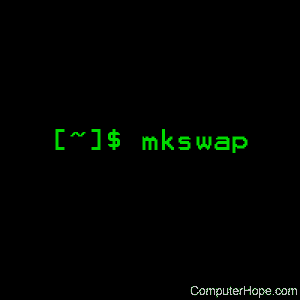Linux mkswap command

mkswap sets up a Linux swap area.
Description
mkswap sets up a Linux swap area on a device or in a file.
The device argument usually is a disk partition (something like /dev/sdb7), but can also be a file. The Linux kernel does not look at partition IDs, but many installation scripts assume that partitions of hex type 82 (LINUX_SWAP) are meant to be swap partitions. (Solaris also uses this type. Be careful not to accidentally kill your Solaris partitions, if you have any, by mixing them up!)
The size parameter is superfluous but included for backward compatibility. (It specifies the desired size of the swap area in 1024-byte blocks. mkswap uses the entire partition or file if it's omitted. Specifying it is very dangerous: a typo can destroy your data. REPEAT, BE VERY CAREFUL WHEN SPECIFYING PARTITION SIZES MANUALLY! A TYPO CAN DESTROY THE DATA ON YOUR DISK!)
After creating the swap area, you need the swapon command to start using it. Usually, swap areas are listed in /etc/fstab so they can be taken into use at boot time by a swapon -a command in some boot script.
Important information and warnings
The swap header does not touch the first block. A boot loader or disk label can be there, but it is not a recommended setup. The recommended setup is to use a separate partition for a Linux swap area.
mkswap, like many others mkfs-like utilities, erases the first partition block to make any previous filesystem invisible.
However, mkswap refuses to erase the first block on a device with a disk label (SUN, BSD, etc.) and on a whole disk (e.g., /dev/sda).
Syntax
mkswap [options] device [size]
Options
| -c, --check | Check the device (if it's a block device) for bad blocks before creating the swap area. If any bad blocks are found, the count is printed. |
| -f, --force | Go ahead, even if the command is stupid. Forces the creation of a swap area larger than the file or partition where it resides. Also, without this option, mkswap refuses to erase the first block on a device with a partition table and on a whole disk (e.g., /dev/sda). |
| -L, --label label | Specify a label for the device, to allow swapon by label. |
| -p, --pagesize size | Specify the page size (in bytes) to use. This option is usually unnecessary; mkswap reads the size from the kernel. |
| -U, --uuid UUID | Specify the UUID to use. The default is to generate a UUID. |
| -v, --swapversion 1 | Specify the swap-space version. (This option is currently pointless, as the old -v 0 option has become obsolete and now only -v 1 is supported. The kernel has not supported v0 swap-space format since 2.5.22 (June 2002). The new version v1 is supported since 2.1.117 (August 1998).) |
| -h, --help | Display help text and exit. |
| -V, --version | Display version information and exit. |
Notes
The maximum useful size of a swap area depends on the architecture and the kernel version. It is roughly 2 GiB on i386, PPC, m68k and ARM, 1 GiB on sparc, 512 MiB on mips, 128 GiB on alpha, and 3 TiB on sparc64. For kernels after 2.3.3 (May 1999), there is no such limitation.
Note that before version 2.1.117, the kernel allocated one byte for each page, while it now allocates two bytes, so that taking into use a swap area of 2 GiB might require 2 MiB of kernel memory.
Presently, Linux allows 32 swap areas (this was 8 before Linux 2.4.10 (Sep 2001)). The areas in use are shown in the file /proc/swaps (since 2.1.25 (Sep 1997)).
mkswap refuses areas smaller than 10 pages.
If you don't know the page size your machine uses, you can look it up with "cat /proc/cpuinfo" (you may not find it, as the contents of this file depend on architecture and kernel version). To set up a swap file, it is necessary to create that file before initializing it with mkswap, e.g., using a command like:
dd if=/dev/zero of=swapfile bs=1024 count=65536
Note that a swap file must not contain any holes (so, using cp to create the file, for example, is not acceptable).
Examples
mkswap /dev/sdc1
Prepares the partition /dev/sdc1, setting it up for use as a swap partition. This space can then be activated using the swapon command.
Related commands
fdisk — A disk partitioning utility.
swapon — Enable a Linux swap area.
